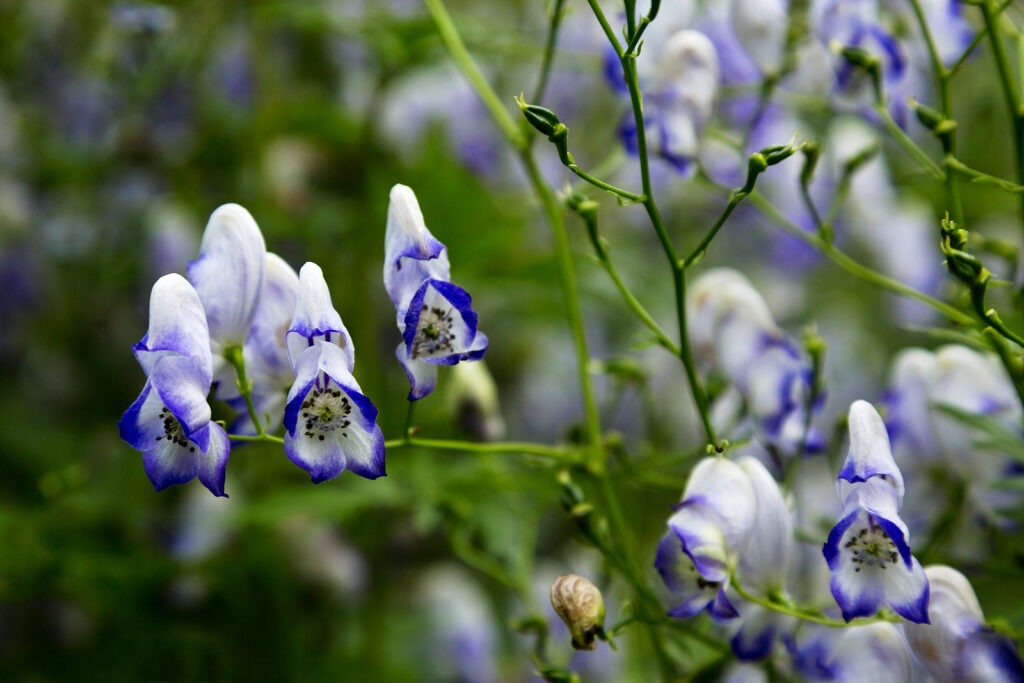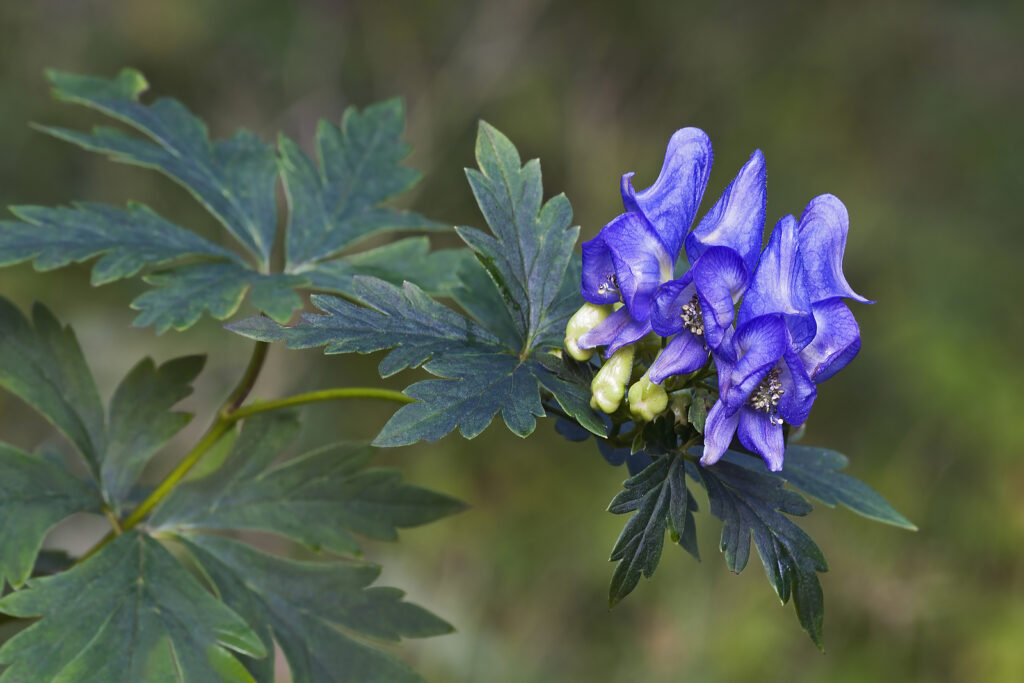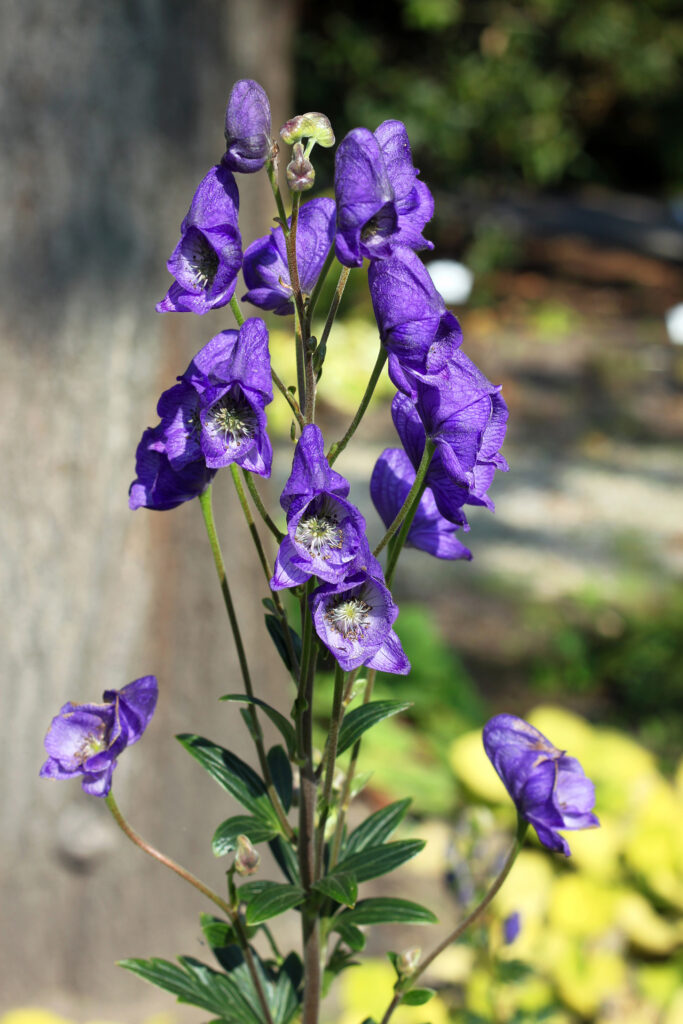Aconitum–commonly called monkshood–is a tall, delphinium-like plant with hooded blue or purple and sometimes yellow flowers. Flowers appear on erect racemes. Aconitum can be used as a tall foundation plant, in semi-wild gardens, and lightly shaded borders.
Aconitum is slow growing at first but grows faster once established. Aconitum may struggle where summers are hot or where nighttime temperatures are greater than 70°F (21°C). Aconitum does not grow well in much of the South, Southwest, and West. Plants need winter chill (temperatures below freezing) and moist, fertile soil for success.
Flowers are borne above clumps of deeply cut or lobed leaves that appear in a palmate (handlike) fashion.
Garden Success Products at Amazon:
- 10 pcs Stainless Steel Garden Hand Tool Set
- Flexi Hose with 8-inch Nozzle
- Gorilla Cart 4 Cu. Ft, 300-pound Capacity
- Neem Bliss 100-% Cold Pressed Neem Oil
- Safer Brand Insect Killing Soap
- Wildflower Seed Mix Attracts Hummingbirds and Butterflies
- Eden Brothers All Perennial Seed Mix
The Aconitum genus contains 100 species of perennials and biennials commonly called monkshood or aconites.
One note: Aconitum is poisonous and should grow out of reach of children.

Get to know Aconitum
- Plant type: Perennial
- Growing zones and range: Zones 3 to 8
- Hardiness: Hardy to -30°F (-34°C), will die back with frost and reemerge in spring; sensitive to heat
- Height and width: 2 to 3 feet tall (61-91cm) and 2 to 3 feet wide.
- Foliage: Clumps of dark green, celerylike foliage grow from tuberous roots
- Flower form: Tubular or hooded flowers on tall spires
- Flower color: Blue, mauve, yellow; some blues are frosted with white
- Bloom time: Mid to late summer to early fall; good color for the fall garden.
- Uses: Good choice for the middle to the back of beds and borders; a good addition to shady beds and woodland gardens.
- Garden companions: Globe thistle, meadow phlox, goatsbeard, fragrant bugbane
- Common name: Azure monkshood
- Botanical name: Acontium carmichaelii
- Family: Ranunculaceae

Where to plant Aconitum
- Plant Aconitum in full sun to light shade; afternoon shade is best. Monkshood thrives in shade.
- Aconitum prefers well-drained, humus-rich soil. Add plenty of aged compost to the planting bed ahead of planting.
- Aconitum prefers a soil pH of 6.5 to 7.5.
Aconitum uses and companions
- Use Aconitum in borders and shade gardens.
- Aconitum’s vertical spires of flowers are an attractive contrast with daisy-like fall flowers.
- Aconitum’s upright spires have the effect of delphiniums and can substitute for them in shaded locations.
- Good companions include Anemone hybrida, Astilbe, Hosta, and Thalictrum.
When to plant Aconitum
- Plant established plants in spring or fall.
- Transplant starts outdoors in late spring.
- Sow seed indoors after prechilling for 6 weeks. Germination can take from a week to a year at 55° to 65°F (12.8-18°C).
- Sow seed outdoors after the last frost in spring.
Planting and spacing Aconitum
- Sow Aconitum seed in six-packs or small pots in potting soil; sow two seeds per hole; sow seed 1/4 inch deep and keep the containers in the light near 60°F (15.6°C) until seedlings are several inches tall; then pot up to next largest container.
- Sow seeds outdoors in fall for germination in spring or prechill and plant them outdoors in early spring; sow seeds 1/4 inch deep.
- Thin or transplant seedlings outdoors when they are 5 to 6 inches 12.7-15cm) tall.
- Space Aconitum 10 inches to 3 feet (25-91cm) apart.

How to water and feed Aconitum
- Water Aconitum moderately unless it is in full sun. In full sun, water more often.
- Mulch to conserve soil moisture and keep roots cool in warm and hot regions.
- Feed with a slow-release fertilizer or feed every 6 weeks with a bloom-boosting fertilizer.
- Aconitum does not like to be divided or transplanted.
Aconitum care
- Stake Aconitum that grows tall and floppy.
- Aconitum can be prone to crown rot or mildew in wet and rainy regions.
Aconitum pests and diseases
- Aconitum is rarely bothered by pests or diseases.
Aconitum propagation
- Divide plants when new growth begins in spring after all danger of frost has passed; divide plants every three years if crowded.
- Divide Aconitum every 3 to 4 years. Handle the roots carefully.

Aconitum varieties to grow
- Acontium x cammarum, bicolor monkshood: Grows 3 to 4 feet tall with violet-blue, bluish-purple, or blue-and-white flowers; ‘Bicolor’ bears loose clusters of blue and white flowers; ‘Bressingham Spire’ bears violet-blue flowers on 3-foot plants.
- A. carmichaelli, azure monkshood: Species grows 3 to 6 feet tall with violet-blue flowers; ‘Arendsii’ bears violet-blue flowers on 3 to 4-foot plants.
- A. lycotonum, wolfsbane: produces yellow or purple flowers on 2- to 6-foot plants.
- A. napellus, common monkshood: Old-fashioned species grow 3- to 4-feet tall with dense, showy clusters of dark blue-violet flowers.
Aconitum is poisonous
- Aconitum is poisonous. Do not plant it where curious children, adults, or pets can reach it. Contact with foliage can cause a rash.
Aconitum frequently asked questions
Q: What growing conditions does Aconitum (monkshood) prefer?
A: Grow Aconitum in humus-rich soil that is cool and moisture-retentive. Mulch around plants in warmer southern gardens to keep the soil cool and moist. Aconitum has tuberous roots so it tends to be drought resistant, but prefers moister parts of the garden and partial shade.
Q: How do I propagate monkshood?
A: Aconitum (monkshood) roots can be divided between autumn and spring. Wear gloves, the roots are poisonous. Sow seeds in early or mid-spring.



